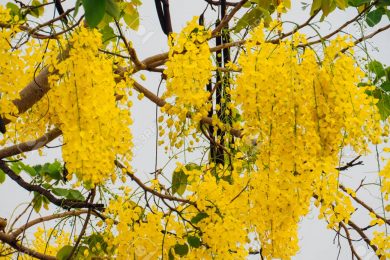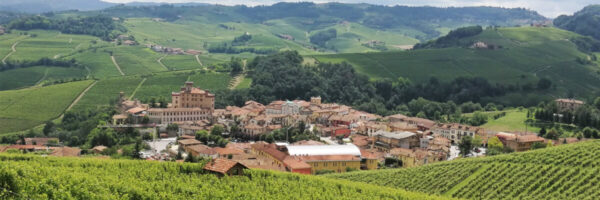
My Orchid Fever – Thailand Orchids
I love orchids! I was never raised in the world of orchid appreciation, but over the years I have come to understand how amazing they are, the many varieties, colours and the push/pull of wild orchids vs the extreme hybrids. As this is an April/May edition of Expat Life Thailand and as the theme of “culture” swarms us throughout many of the various festivals of spring on the way, I am sure there will be plenty of orchids decorating floats, cakes, parties and tables. The official botanical name of the National Flower of Thailand is the Cassia fistula and is known as Ratchaphruek, which means royal tree, a gorgeous array of bright yellow orchids hanging from the stem.
Thailand Orchids

As I am still carousing Asia and in and out of Thailand, I had the pleasure of renewing my visa in Singapore, however after once you’ve exhausted the few tourist attractions like Gardens on the Bay and the Light and Sound Show in the same area, done your specialty shopping of items one might only be able to get in London or high priced cities like Singapore, then the Botanical Gardens is the place I usually end up. This time I took specific care to peruse the National Orchid Garden to get some great shots to share with you and to save for future painting possibilities. Since the time I painted the botanical painting in this article, the Paphiopedilum, I have learned how to spell it right, with an M at the end, not an N! But, that was back in 2009, like I said, I was not raised with orchids in my life but now that I live in Asia, a decade on, they are much more in my daily eyesight! What a faux pas for me after all that work! Hence, now I have some beautiful pictures to stimulate me again. Now for some enlightening orchid information!
One can find wild orchids in the jungles of Thailand still clinging to old growth in places like Khao Sok National Park, but the vast majority of orchids are to be found in flower markets and specialty farms in the countryside. Thailand is known as the “Land of the orchids” or, “Gluay Mhai”. There are over 25,000 species of orchid flowers known to exist thriving in a number of environments. Some grow underground, in the soil and on rocks but the majority grow on other plants and trees. Some orchids are parasitic obtaining food from fungi that lives inside its roots. Asia has the largest and widest variety of orchids in the world so has the greatest potential for creating modern hybrids.
Some Survive Longer Than Others

Some orchid flowers survive only a few hours while others can survive up to 6 months. The world’s largest orchid is the Grammatophyllum speciosum and can grow to be 2.5m in length and weight up to one ton. The world’s smallest orchid is the Platystele genus and is just over 2 millimetres and was found hiding amongst the roots of another flower in Ecuador in 2009. More and more hybrids are being created all the time and sometimes up to 5 different parents are used to create a new designer orchid! It is an incredible process of hand pollination, and one to be admired with the consistency and dedication of orchid lovers (and botanical institution employees), however with this hybridisation, the insects that used to be needed for the wild orchids have less use with all the hand pollination occurring in which case, insect extinction can occur. Many insects and birds have evolved for specific pollination purposes, both the pollinator and the pollinated evolving together over time. This is why at the beginning of this article I mention my push/pull of admiration between both the wild and the hybrid orchid.
Represents Friendship and Nobility
Orchids are known to represent friendship, elegance and nobility. The earliest documented time of orchid acknowledgement is traced back to the 28th century BC. The term, ‘orchid’ comes from a Greek word that means testicle, due to the way in which the roots can hang. Orchids come in all colours of the rainbow, mostly in whites, purples and hot pinks but yellows and creams, golds, maroons and even blues and greens can be found. There are also spotted and mixed coloured orchids and too huge an array of various shapes and sizes to even calculate. I saw all these colours at the National Orchid Garden in Singapore, the displays were out of this world, impressing my mind even as now, these days, I am an avid orchid seeker. I’ve seen orchids in the UK, USA, Cape Town, Hawaii and all over Asia, but, as a restless tourist awaiting my visa, these colourful orchids at the gardens brightened my time! The Singapore Botanical Gardens are free and there is a SGD5 cover charge for the orchid area, it is well worth it!
Other than just suffusing our surroundings with gorgeous flowers and vibrancy, there are also a few traditional medicinal ways orchids have been used over the centuries throughout the world. Since the stems and bulbs are designed to keep the plant alive during dry season, this is the part of the plant rich in nutritive substances. Local indigenous and ethnic communities around the world have used these parts to speed recovery after an illness and immune system buildup, gastro-intestinal issues, sexual improvement for men’s stamina and recovery after sex. Aphrodisiacs and love potions have been created with the dried flowers although I don’t know what kind of real research is done within this type of assumptions, but there are some orchids that produce a divine scent when fresh. There is a science in the fact that scent can stimulate memory, attraction and disgust! In the past, eyesight and bowel issues were attended to with boiled and mashed roots as in a poultice.

Thailand Orchids for Cancer Recovery
Recent research is discovering ways to help a patient with cancer recovery after chemotherapy use the roots of an orchid as a medicinal tea. As a Thai tradition and custom, the locals dip the Dendrobium flowers in batter and deep fry them adding that to their delicious creations and in India, some orchids are added to curries. It does seem that indigenous knowledge keeps coming to the forefront even as we progress with science. This is perhaps once again, a reason to recognise the importance of not only appreciating the intense beauty and fabulous creations of hybrids, but to keep the wild orchids alive and safe also. Over collecting them out of the wild forests and deforestation in general, as we know, is something to be concerned about these days.
I was reminded of one of my favourite orchids while strolling through the gardens, vanilla! Many people don’t know vanilla, V. planifolia, is an orchid. The Aztecs discovered the plant in Mexico in the early 16th century and used the seed pods (vanilla beans) to aid digestion, counteract poisons and as an aromatic exotic flavouring. Of course we know they also used chocolate, Theobroma cacao, and mixing these two, vanilla and cacao, was believed to give power and strength. Both chocolate and vanilla is a large industry in consumerism (and yumminess!) yet the original indigenous ways of cacao and pure vanilla pod stems from a medicinal value. My next painting is of the Cacao plant and I am working on it in Bali, Indonesia, as I write this.

A few words about the orchid cultivation in Thailand, it is confined mostly to the central plain, mainly in Bangkok and the nearby provinces. There are 3 main farms scattered about including Bangkok, Samut Sakhon and Nakhon Pathom. In the north closer to Chaing Mai, I can recommend Sainamphung Orchid Farm. All orchid species are protected by CITES, the Convention on International Trade in Endangered Species, which requires certification of plants crossing international borders. If you would like a fun read about the hilarity of orchid growers around the world and their mindset, please find yourself a copy of Orchid Fever by Eric Hansen. I hope you enjoy the coming season in our SE Asian lifestyle and that Thailand brings you much colour, scent and variation as the beautiful orchids of our world do!



